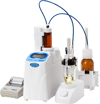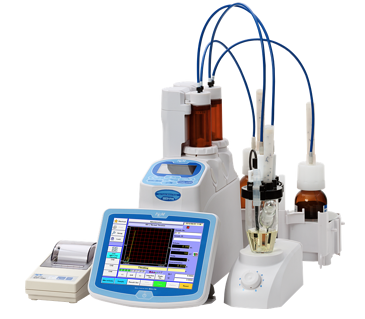Common Applications for Volumetric Titration
- ASTM E203: Standard test method for water using volumetric titration
- ISO 760: Determination of water - Karl Fisher method
Product Specifications
Models available: MKV-710B, MKV-710S, MKV-710M
 MKV-710M (flagship)
MKV-710M (flagship)
-
- midrange level plus
- Lan Connectivity
- Control 4x titrators simultaneously
 MKV-710S (midrange)
MKV-710S (midrange)
-
- entry level plus
- 8.4 inch controller
- Wireless or wired
 MKV-710B (entry)
MKV-710B (entry)
-
- 2 x burette capable
- USB thumbdrive export
MKV-710 Specifications:
- Measuring Range: Water Content 0.1 to 500mgH2O, Concentration 10ppm to 100%H2O
- Burette Precision: Volume 10mL burette, discharge +-0.015mL, Repeatability +-0.005mL
- Endpoint Detection: by polarized potential level detected with a twin platinum electrode
- Required solvent: 30 to 100mL if using standard S-type titration vessel
- Methods saved: 120 for model M/S and 20 for model B
- Data storage: 500 samples for model M/S and 100 samples for model B
- External I/O: RS-232, USB Thumbdrive, SS-Bus, and Lan connection for model M
- Ambient conditions: Temperature 5 to 35 degree C, 85% RH or below
- Burette Capacity: Standard with 1ea 10mL burette expandable to 2ea 10mL burette
- Operation: Touch Panel or sheet key
Reagents for Volumetric Karl Fischer Titrators
A word about Volumetric reagents, titrants, and solvents:
"Composites" are referred to as one-component where as "Titrants" are referred to as two-component. What exactly does that mean?
- One-component reagents or "composites" have everything necessary for the titration of water. All that is required beyond the composite is an ordinary methanol solvent inside the titration vessel to inject sample into for testing. Over time water will lessen the strength of the composite and therefore it will be important to update the composites factor or "strength" from time to time.
- Two-component reagents or "Titrants" have separated some of the reagent components out and into the solvent. In this case a specific solvent must be used to work with the Titrant for everything to function correctly. A benefit of this is that the titrant only becomes active once combined with the specific solvent. This helps provide longer stability and life of the reagents.
 MKV-710M (flagship)
MKV-710M (flagship) MKV-710S (midrange)
MKV-710S (midrange) MKV-710B (entry)
MKV-710B (entry)